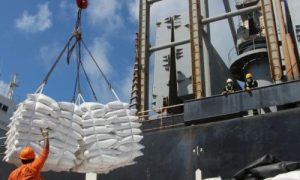Aus rice production woes

Aus rice production in the country has fallen short of the government-set target by more than nine lakh tonnes this year, potentially necessitating rice imports to ensure food security amid worries about depleting foreign exchange reserves.
According to data from the Department of Agriculture Extension (DAE), the production of Aus rice reached 30.43 lakh tonnes, cultivated across 10.50 lakh hectares of land, falling below the target of 39.77 lakh tonnes produced from 13.95 lakh hectares of land in the current fiscal 2023-24. Moreover, approximately 3,961 hectares of Aus crops were damaged during the season.
The production of Aus rice stood at 29 lakh tonnes in FY23, 32.45 lakh tonnes in FY22, and 32.85 lakh tonnes in FY21.
Due to lower Aus rice production last season, the country had to import 10.55 lakh tonnes of rice in FY23.
Renowned agricultural economist Prof ASM Golam Hafiz expressed concerns about the consecutive decline in Aus production, stating that it undeniably impacts food security. He emphasised the need for the government to take various measures, including rice imports, to mitigate the situation.
With the reduced production, the country is expected to import approximately 10 lakh tonnes of rice during the marketing year (MY) 2023-24, according to the US Department of Agriculture forecast.
In the same forecast for MY24 released this August, the anticipated rice harvested area has been reduced to 11.65 hectares from previously estimated 11.9 million hectares and production to 36.4 million tonnes from 37.1 million tonnes, which is 1.7% and 1.6% lower, respectively.
The Food and Agriculture Organisation of the United Nations’ latest forecast on 12 October stated that the lower than previously anticipated plantings have trimmed the rice production prospects for Bangladesh, Nigeria and the Philippines since September.
Wahida Akter, secretary of the agriculture ministry said, “Our food security doesn’t rely solely on Aus production. We are pleased with the yields from the Aus season, and we anticipate a bumper harvest during the Aman and Boro seasons this year.”
She emphasised, “The Boro is the main season for rice production, contributing a substantial quantity to our national food supply. Additionally, the Aman season also adds significantly to our food reserves.”
She also pointed out, “We acknowledge the importance of the Aus season and have set ambitious targets for it. However, due to changing rainfall patterns attributed to climate change, Aus production has not seen the expected increase this year. Aman, being rain-dependent, is also affected by these climate shifts.”
Agricultural economist and researcher Dr Jahangir Alam Khan told the Daily Sun that lower rainfall and a prolonged heat wave hampered Aus rice cultivation in many areas of the country this year.
Echoing the sentiment of the agriculture secretary, he, however, mentioned that Aus contributes around 7% of the total rice production of the country of the total rice production in the country, so the output falling short of target is not expected to have a broad-reaching impact. “If the Aman and Boro seasons can achieve robust production, the country will not need to import rice this year.”
Agriculture Minister Muhammad Abdur Razzaque, while speaking at a programme organised by Bangladesh Agricultural Journalists Forum recently, also expressed that there is no need to import rice this year, as agricultural mechanisation has helped Bangladesh produce enough rice this time.
Rice prices normally rise during Ashwin and Kartik months in the Bangla calendar year, but this year the prices are coming down, he said, adding that millers also want to sell rice to the government. “So we don’t have to import this year.”
Bangladesh, along with other South Asian countries, has been affected by the El Niño phase, resulting in a heatwave and reduced rainfall this year. The country experienced a 44% decrease in rainfall in May, a 16% reduction in June, and a 51% decline in July during the peak of the monsoon season, as reported by the Bangladesh Meteorological Department.
The cultivation of the three major rice crops – Aus, Aman, and Boro – constitutes 100% of total rice production in the country, with each crop grown in a different season.
Aus rice is typically planted in March-April and harvested in June-July, synchronizing with the hot summer climate that prevails from March to May.
Source Link: https://www.daily-sun.com/post/718013














